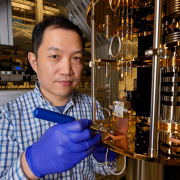A new type of vaccine developed by researchers at the University of Chicago’s Pritzker School of Molecular Engineering has shown that it can reverse autoimmune diseases like multiple sclerosis and type 1 diabetes in lab tests — all without shutting down the rest of the immune system.
Trials are only just beginning in humans, but researchers say the method holds promise.
“In the past, we showed that we could use this approach to prevent autoimmunity,” said Jeffrey Hubbell, the Eugene Bell Professor in Tissue Engineering and lead author of the new paper. “But what is so exciting about this work is that we have shown that we can treat diseases like multiple sclerosis after there is already ongoing inflammation, which is more useful in a real-world context.”
A typical vaccine teaches the human immune system to recognize a virus or bacteria as an enemy that should be attacked. The new “inverse vaccine” does just the opposite: it removes the immune system’s memory of one molecule.
While such immune memory erasure would be unwanted for infectious diseases, it can stop autoimmune reactions like those seen in multiple sclerosis, type I diabetes, or rheumatoid arthritis, in which the immune system attacks a person’s healthy tissues.
Unwinding an immune response
The job of the immune system’s T cells is to recognize unwanted cells and molecules — from viruses and bacteria to cancers — as foreign to the body and get rid of them. Once T cells launch an initial attack against an antigen, they retain a memory of the invader to eliminate it more quickly in the future.
T cells can make mistakes, however, and recognize healthy cells as foreign. In people with multiple sclerosis, for instance, T cells mount an attack against myelin, the protective coating around nerves.
Today, autoimmune diseases are generally treated with drugs that broadly shut down the immune system.
“These treatments can be very effective, but you’re also blocking the immune responses necessary to fight off infections and so there are a lot of side effects,” said Hubbell.
Hubbell and his colleagues wanted to explore an alternative approach. They knew that the body has a mechanism for ensuring that immune reactions don’t occur in response to every damaged cell in the body — a phenomenon known as peripheral immune tolerance, which is carried out in the liver.
They discovered in recent years that tagging molecules with a sugar known as N-acetylgalactosamine (pGal) could mimic this process, sending the molecules to the liver where tolerance to them develops.
“The idea is that we can attach any molecule we want to pGal and it will teach the immune system to tolerate it,” explained Hubbell. “Rather than rev up immunity as with a vaccine, we can tamp it down in a very specific way with an inverse vaccine.”
In the new study, the researchers focused on a multiple-sclerosis-like disease in which the immune system attacks myelin, leading to weakness and numbness, loss of vision and, eventually mobility problems and paralysis. The team linked myelin proteins to pGal and tested the effect of the new inverse vaccine in animals. The immune system, they found, stopped attacking myelin, allowing nerves to function correctly again and reversing symptoms of disease.
In a series of other experiments, the scientists showed that the same approach worked to minimize other ongoing immune reactions.
Toward clinical trials
Initial phase I safety trials of a glycosylation-modified antigen therapy based on this preclinical work have already been carried out in people with celiac disease, and phase I safety trials are under way in multiple sclerosis.
Those trials are conducted by the pharmaceutical company Anokion SA, which helped fund the new work and which Hubbell cofounded and is a consultant, board member, and equity holder. The Alper Family Foundation also helped fund the research.
“There are no clinically approved inverse vaccines yet, but we’re incredibly excited about moving this technology forward,” said Hubbell.
Citation: “Synthetically glycosylated antigens for the antigen-specific suppression of established immune responses,” Tremain et al, Nature Biomedical Engineering, September 7, 2023. DOI: 10.1038/s41551-023-01086-2
Funding: Chicago Immunoengineering Innovation Center, Alper Family Foundation and Anokion SA
Adapted from an article by Sarah C.P. Williams first published by the Pritzker School of Molecular Engineering.

